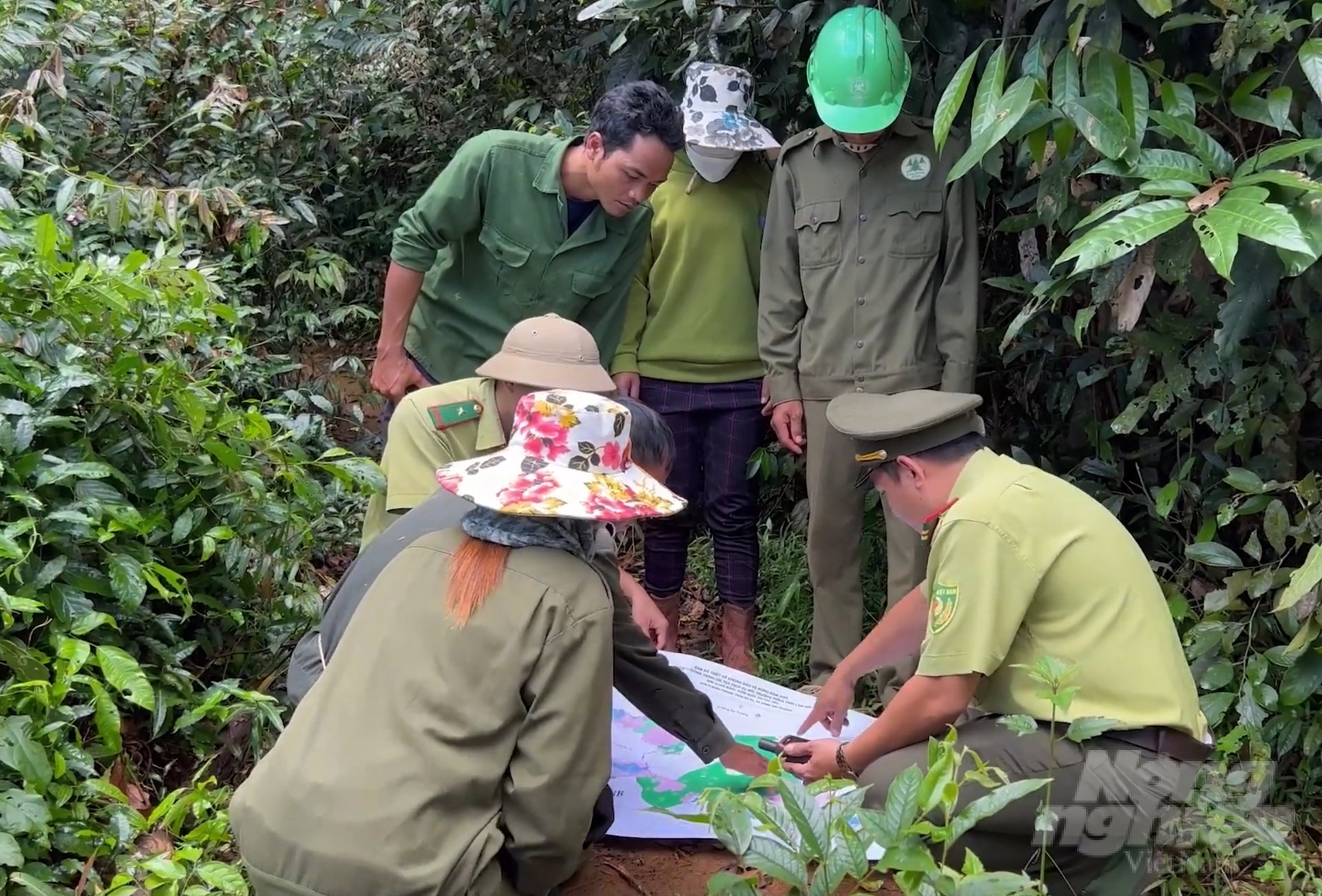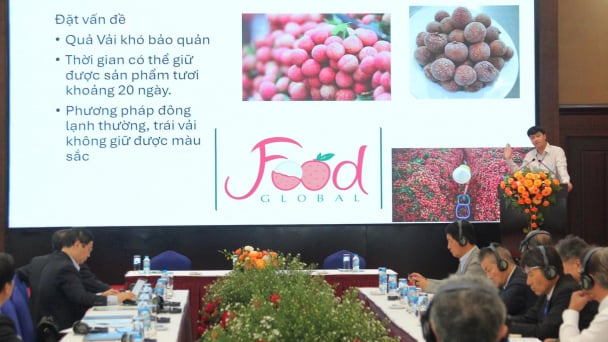June 16, 2025 | 04:19 GMT +7
June 16, 2025 | 04:19 GMT +7
Hotline: 0913.378.918
June 16, 2025 | 04:19 GMT +7
Hotline: 0913.378.918

Rangers of Cuc Phuong National Park patrol in the forest. Photo: Dinh Tung.
On August 17, the Party Central Committee Secretariat issued Conclusion No. 61-KL/TW on continuing to implement Directive 13-CT/TW (dated January 12, 2017) of the Secretariat on “Strengthen the Party’s leadership in forest management, protection, and development.”
This calls for timely and rigorous promotion of the implementation of Conclusion 61-KL/TW and consultation from the 6-year implementation of Directive 13-CT/TW on the policy of promoting land allocation, forest allocation, and more effective natural forest management.
The Vietnam Association of Agricultural Economic Sciences and Rural Development coordinated with the Center for Highland Natural Resource Governance Research (CEGORN) to organize research and field surveys in Lao Cai and Dak Lak provinces. They organized a workshop with representatives of many state management agencies, professional associations, research organizations, forest owners, scientists, and related experts at Thai Nguyen University on August 30.
The Vietnam Association of Agricultural Economic Sciences and Rural Development synthesized and assessed comments from participants in the survey localities and at the workshops. They came to the following conclusions.
State agencies need to urgently appraise, approve and announce the National Forestry Plan to ensure consistency with land use planning. The national and provincial plans need to clearly define the space and the size of forested and non-forested land, reserved for forest development by new planting or natural regeneration.
The Ministry of Agriculture and Rural Development and the Ministry of Natural Resources and Environment advise the National Assembly and the Government to regulate criteria for forestry land uniformly (special-use forest land, protection forest, and production forest) in the Land Law (amended). changes) in synchronization with the Forestry Law, including land that already has forests and land that has not been planned for forest development to ensure the implementation of the Party’s resolution XIII to increase forest coverage to 43%.

Strengthening the Party’s leadership is the force for forest management, protection and development. Photo: Viet Khanh.
The Government should promulgate mechanisms and policies to protect and develop sustainable forests based on summarizing the practical implementation of Decree 75/2015 of the Government; Decision 38/2016 of the Prime Minister; and other relevant legal documents. At the same time, leaders should fully and promptly institutionalize the policies in Conclusion 61-KL/TW on expanding land and allocating to households, individuals, communities, and village residents through policy mechanisms. This will resolve problems in the practical implementation of the mechanism for ordering public benefits to manage and protect special-use forests, protection forests, and natural forests that are production forests and are closed for logging.
The leaders need to review and supplement the Government's regulations in Decree 156/2018 on forest protection funds and legal regulations on trade quantification to concretize policies and smoothly operate the mechanism to form the credit market. greenhouse gas absorption only (both voluntary and mandatory market); summarize the practice of promulgating regulations and standards and managing natural forest reclamation. These processes should align with the changing trend of international traceability of goods in the Central Highlands region. It is necessary to have a practical program on forest restoration, protection and development to resolve the encroachment situation, striving for forestry land acquisition and sustainable development.
National Forestry Plan should focus on directing and urgently implementing the sustainable forest protection and development program for 2021-2025, allocating funding from the Central budget to ensure enough resources to implement this program.

People living near the forest and rangers coordinate to patrol and protect the forest. Photo: Hong Thuy.
The leaders need to promote land and forest allocation so that “forests have real owners,” focusing on preparing cadastral records and forest records to complete the issuance of forestry land use rights certificates to forest owners. Focus on land and forest allocation according to the Forestry Law will help households and communities living near forests and in forests in association with policies to support ethnic and mountainous people, contributing to hunger eradication and sustainable poverty reduction. Leaders should continue to improve legal regulations on the legal status of households, individuals, and communities as forest owners.
The Government needs to manage natural and close logging forests, but have flexibility with different forest uses, ensuring harmony with international commitments and agreements. Regulations should aim to restore and improve the quality of natural forests to preserve biodiversity and provide forest environmental services. Regulators should develop agroforestry and non-timber forest products for commodity production. This will minimize the conversion of natural forest uses to non-forestry purposes and activities that cause forest loss and degradation, improve forest quality, and sustainably manage forest resources.
National Forestry Plan should apply new science and technology, innovation, and digital transformation, and build a system to investigate and monitor developments in forest resources nationwide in a modern, effective and unified manner. This goes hand in hand with effective and substantial digital transformation, innovation and creativity programs in the forestry industry. Leaders should strengthen forest governance capacity for forest owners by establishing a forest resource monitoring and evaluation system, promote the application of remote sensing technology, geographic information systems, and information technology in forestry management; and investigate and evaluate national forest resources.
Translated by Quynh Chi

(VAN) The UNESCO Global Geopark revalidation of Non nuoc Cao Bang and the transition to a two-tier administrative model are presently undergoing a pivotal moment in Cao Bang, the northernmost province of Vietnam.
/2025/06/13/5330-2-004539_953.jpg)
(VAN) Changing policy mindset and removing investment barriers are urgent requirements to open up new development space for enterprises in the agricultural sector.

(VAN) The areas include the restoration of five million hectares of marine ecosystems.

(VAN) Dr. Le Van Nguyen, Director of the Institute of E-Commerce Management (ECM), emphasizes the potential for green development through the cultivation of fruit trees, particularly in provinces such as Son La.

(VAN) VAAS and numerous Vietnamese enterprises have signed cooperation agreements with Japanese partners to promote agricultural technology and trade connectivity.
/2025/05/29/5625-12-214801_567.jpg)
(VAN) Provincial mergers in the Mekong Delta promise to streamline administration, expand inter-provincial raw material areas, and foster close linkages in agricultural value chains, benefiting both businesses and cooperatives.

(VAN) Merging Mekong Delta provinces contributes to the expansion of agricultural raw material areas, addressing previous constraints caused by provincial boundaries. Additionally, this expansion will reduce costs and strengthen linkages between businesses, cooperatives, and farmers.